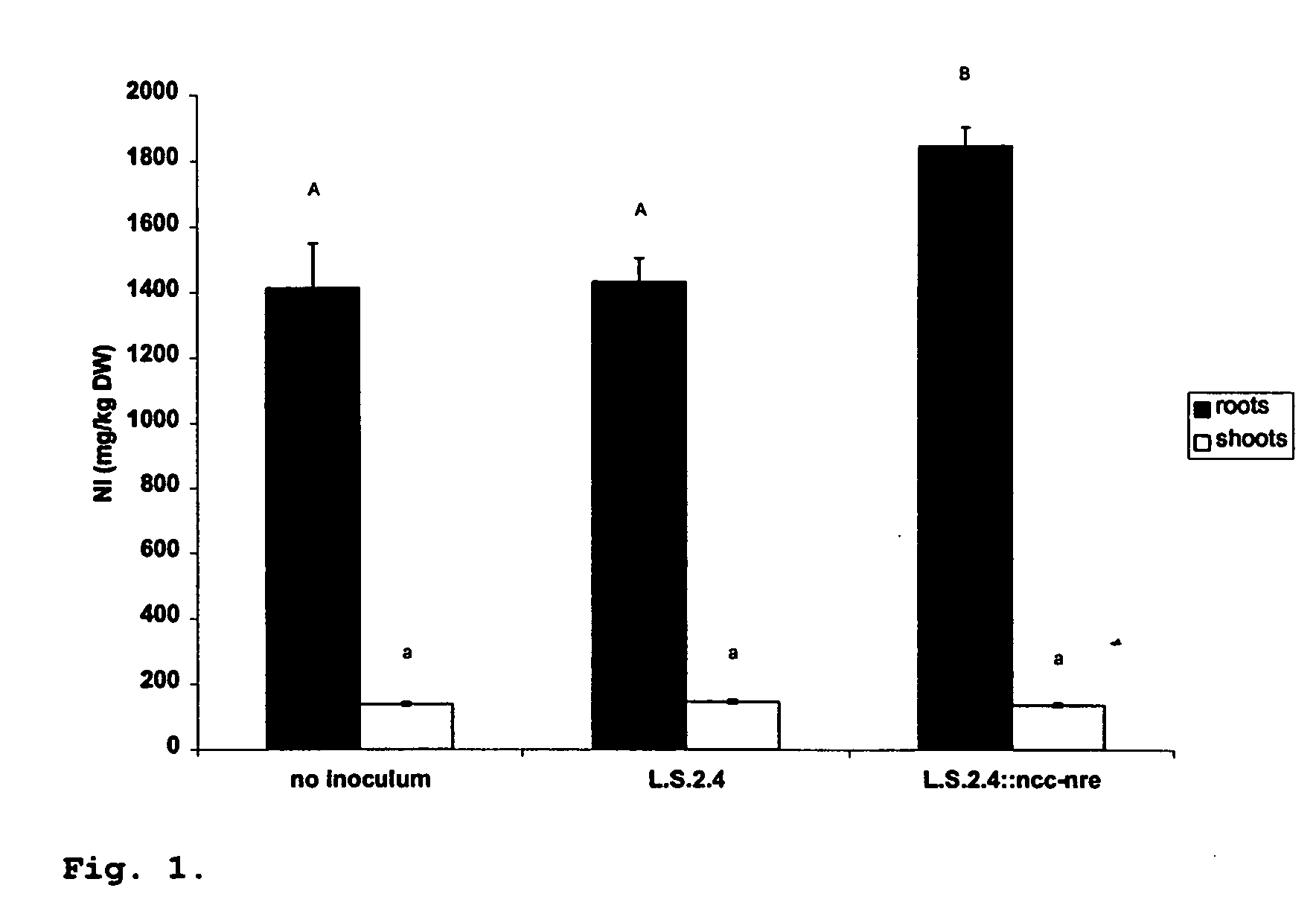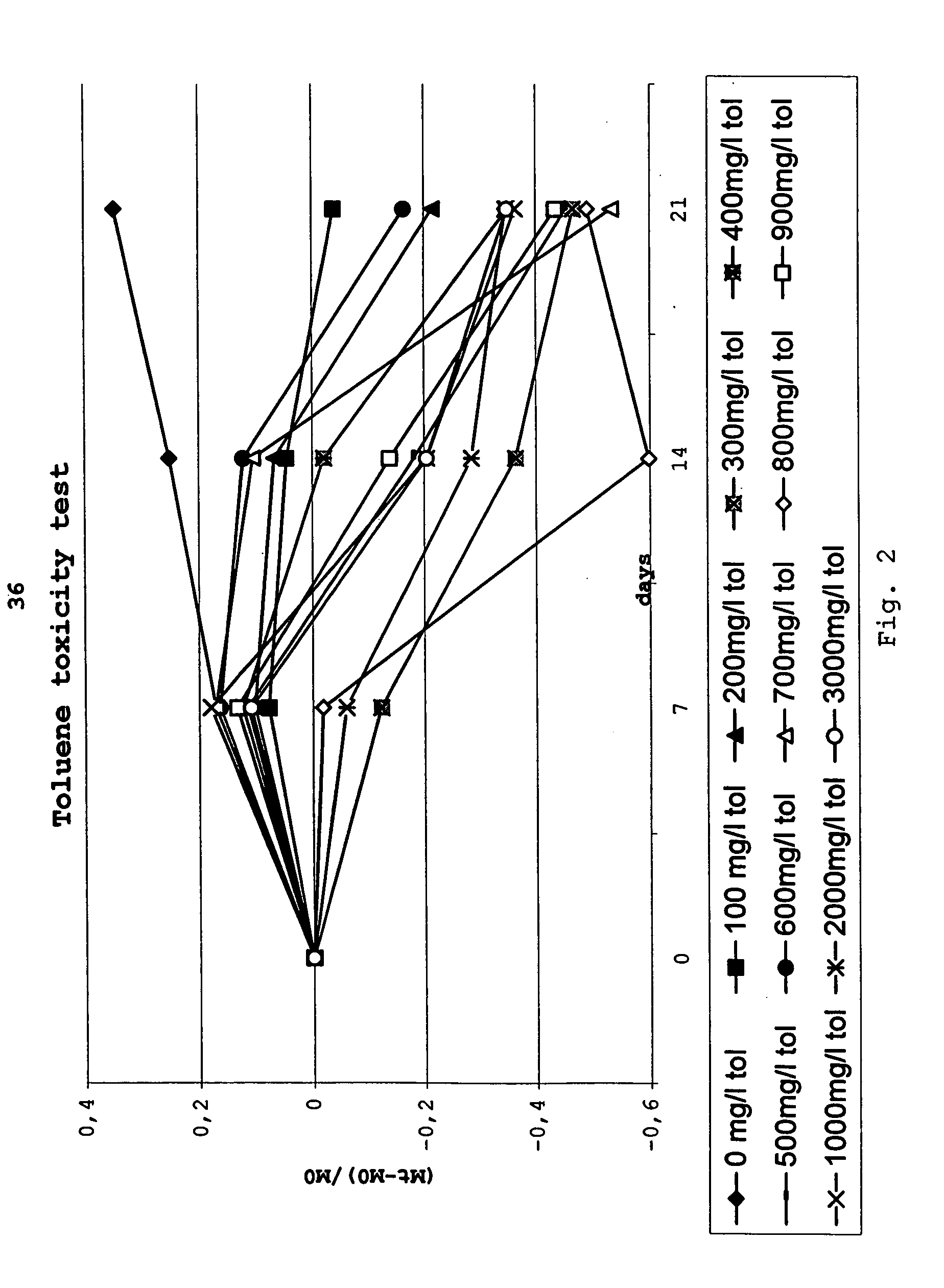Method for improving phytoremediation treatment of a contaminated medium
a technology for contaminated medium and phytoremediation, applied in biochemistry apparatus and processes, water/sludge/sewage treatment, application, etc., can solve the problems of not being degraded, accumulation of toxic metabolites, and important soil pollution by toxic organic compounds, so as to reduce the accumulation of toxic metabolites, and reduce the effect of phytovolatilization
- Summary
- Abstract
- Description
- Claims
- Application Information
AI Technical Summary
Benefits of technology
Problems solved by technology
Method used
Image
Examples
example 2
Construction of Recombinant Endophytic Strains Equipped with Degradation Pathways for Specific Organic Xenobiotics
[0031] For construction of strains of endophytic bacteria with improved degradation capacity of organic xenobiotics (benzene, toluene, phenols and TCE) natural gene transfer was used. Natural gene transfer is based on bi or tri parental conjugation or exogenous plasmid isolation.
[0032] As a model endophytic strain to be equipped with degradation pathways was used a nickel-kanamycin marked derivative of Burkolderia cepacia L.S.2.4 named strain BU 0072, which was constructed at VITO (Taghavi, S. et all, 2001). Burkolderia cepacia L.S.2.4 has yellow lupine (Lupinus luteus L.) as host.
[0033] As a donor strain for degradation pathway Burkolderia cepacia G4 (TOM, conjugative plasmid, tol+) was used.
[0034] Donor strain and receptor strain were grown overnight in LB medium, washed in 10−2 MgSO4 and aliquots of 100 μl were added to a sterile filter (0.45 μl) and incubated ove...
example 3
Development and Comparison Techniques for Efficient Reinoculation of Endophytic Strains in their Host Plants
[0041] After having marked and equipped endophytic bacteria with degradation pathways an efficient recolonization of host plant is an important prerequisite to evaluate their contribution inside of the plant to degrade the pollutants as they are being transported trough the plant and consequently reduce phytotoxicity and volatilization of the pollutants.
Preparation of Bacterial Inoculum:
[0042] A VM 1330 strain was grown in 284 tris buffered, salted, minimal liquid medium with addition of 0.2% gluconate at 22° C. on rotary shaker for a period of 7 days. Next, inoculum was centrifuged at 6000 rpm during 15 minutes, washed twice in MgSO4−2. Inoculum was diluted and plated on 284 medium with addition of 1 mM Ni, 50 mg / l kanamicyne and toluene in order to test the purity of the solution and the presence of Ni, Km and toluene resistance characteristics.
Seeds Surface Sterilizat...
example 4
Improved Phytoaccumulation of Heavy Metals
[0054] In order to exploit the use of endophytic bacteria to improve the phytoextraction of heavy metals, Burkholderia cepacia was selected as endophytic strain. Some B. cepacia strains have been reported as facultative endophytes of lupine plants or were found to colonise roots of various maize cultivars (Hebbar et al., 1992a; Hebbar et al., 1992b).
[0055] Wild type strain Burkholderia cepacia L.S.2.4 and its nickel resistant derivative L.S.2.4::ncc-nre (Taghavi et al., 2001) were inoculated in perlite and the sterile Lupinus seedlings were grown on this substrate for 21 days under controlled environmental conditions. Non-inoculated sterile plants were used as controls. In the absence of NiCl2, no difference in growth response was observed between the 21 days-old non-inoculated control plants and the inoculated lupine plants when the shoot biomass and length were considered. The roots seemed to be slightly but significantly affected in the...
PUM
| Property | Measurement | Unit |
|---|---|---|
| concentration | aaaaa | aaaaa |
| temperature | aaaaa | aaaaa |
| retention time | aaaaa | aaaaa |
Abstract
Description
Claims
Application Information
 Login to View More
Login to View More - R&D
- Intellectual Property
- Life Sciences
- Materials
- Tech Scout
- Unparalleled Data Quality
- Higher Quality Content
- 60% Fewer Hallucinations
Browse by: Latest US Patents, China's latest patents, Technical Efficacy Thesaurus, Application Domain, Technology Topic, Popular Technical Reports.
© 2025 PatSnap. All rights reserved.Legal|Privacy policy|Modern Slavery Act Transparency Statement|Sitemap|About US| Contact US: help@patsnap.com


